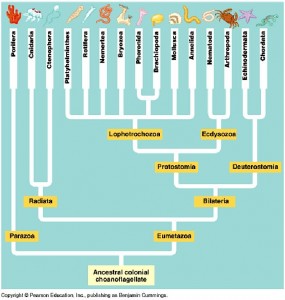This story appeared on Science Daily, based on a press release from CNRS in France:
Segmentation Is the Secret Behind the Extraordinary Diversification of Animals
ScienceDaily (July 27, 2010) — Segmentation, the repetition of identical anatomical units, seems to be the secret behind the diversity and longevity of the largest and most common animal groups on Earth. Researchers from CNRS and Université Paris Diderot have shown that this characteristic was inherited from a common segmented ancestor thought to have lived 600 million years ago and whose presence "changed the face of the world."
...
[Arthropods, vertebrates, and annelids] are not closely related to one another. So, where does their segmentation come from? Is it possible that they all inherited this feature from a very distant common ancestor that lived 600 million years ago, before the Cambrian explosion, which produced most of the large animal groups that exist today? Or has segmentation occurred several times during the history of evolution? This is the question addressed by the researchers of CNRS and Université Paris Diderot at the Institut Jacques Monod, because segments seem to offer a significant advantage to the groups that have them, in terms of diversity, longevity and overall evolutionary success.
...
The researchers found that the genes controlling segment formation during embryo development are almost the same in drosophila (an arthropod) and in annelid marine worms, on which they concentrated their studies. These similarities led them to conclude that the genes had been inherited from a common ancestor, which was itself segmented. It also appears that vertebrates inherited this characteristic from an ancestor they share with the arthopods and the annelids. This is what the researchers are now seeking to confirm.
Arthropods are segmented and very diverse. Nothing newsworthy there. But wait, what's that? The second largest phylum is molluscs, which aren't segmented? And what else? Nematodes, which are undoubtedly hyperdiverse, aren't segmented either? Early-branching animals like sponges, cnidarians, and ctenophores aren't segmented either, you say? Only three phyla are segmented, two of which (Chordata and Annelida) are not as large as Mollusca and Nematoda? Hmmm.
Anyway, the story (which is bad, even by press release standards) suggests that finding a common gene involved in segmentation in three distantly related phyla implies that their common ancestor had the gene and therefore was segmented as well. We've been through this whole "shared regulatory gene equals homology of morphological trait" issue with the eye. The alternative interpretation is that the same genes were co-opted for similar functions independently. The authors of the
original paper dismiss this possibility in one sentence:
"Because they are not known to be part of a conserved core regulatory network or “kernel” that might have been coopted en bloc, each gene would have been recruited independently, which seems unlikely."
Let's think about this for a minute. Yes, it seems "unlikely" that the same genes would be co-opted three times for similar functions. But the hypothesis that the ancestor was segmented requires another major assumption.
Here is a very basic phylogeny from an introductory textbook.

For the ancestor of chordates, annelids, and arthropods to have been segmented, this means that segmentation must have been lost in molluscs, nematodes, echinoderms, brachiopods, rotifers, flatworms, and various smaller phyla. Moreover, several of these phyla that lost segmentation subsequently became more diverse than chordates and annelids.
Another example of misunderstanding phylogenetics.
 For the ancestor of chordates, annelids, and arthropods to have been segmented, this means that segmentation must have been lost in molluscs, nematodes, echinoderms, brachiopods, rotifers, flatworms, and various smaller phyla. Moreover, several of these phyla that lost segmentation subsequently became more diverse than chordates and annelids.
Another example of misunderstanding phylogenetics.
For the ancestor of chordates, annelids, and arthropods to have been segmented, this means that segmentation must have been lost in molluscs, nematodes, echinoderms, brachiopods, rotifers, flatworms, and various smaller phyla. Moreover, several of these phyla that lost segmentation subsequently became more diverse than chordates and annelids.
Another example of misunderstanding phylogenetics. 




Comments